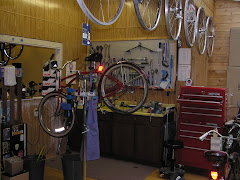Thursday, March 24, 2011
Booby Trap your Bike
This link, How to booby-trap your bike when you forget your lock! , has a great idea for securing your bike (sort of) when you are out for a ride and make an unexpected stop. It was too cool to not share. Thanks Bicycling magazine.
Wednesday, March 23, 2011
Buying a used road bike...
I am asked occasionally about my opinion about buying a used road bike. Here's some things to consider if you are thinking of buying a used one...
* The chain is the first thing to wear out. They are good for about 2k miles max if not kept clean and lubed. If it appears to have a lot of gunk on it you should check closely. A simple way to check the chain is to have it gauged at a shop, or, it is simple to do it yourself. Measure a section of chain that is straight (at least eight links). Holding a tape measure at 1" mark, measure back to as far back as possible in a straight line to another pin that hits an even inch mark. If the chain is new each link pin should be exactly 1" apart (pin center to pin center). When worn as little as 1/32 inch on this type of drive train it will cause shifting problems. A new chain on a nine speed drive train is anywhere from $20 - $50. Ten speed is $35 - $60
* If the chain is well worn it is likely the cassette is also on its way to being replaced. A new cassette will last about 4k miles if kept clean. That is a little harder to gauge so I would suggest bringing it in to a shop to gauge the wear.
* Tires- If a flat spot is found all the way around on the rear tire it was probably used on a trainer. It is not critical, but, flat spots will cause poor cornering. Check the front also, some people mistakenly put a worn rear on the front which is a bad idea. Now we're talking about real bad cornering. This is wear the rubber meets the road. If you are not sure if the tires will last think replacement.
* Check brake pads for wear
* Spin wheels and check to be sure they are "true". Small wobbles can be fixed, kinks in the rim are a warning to possibly stay away. A hump, or flat spot in the wheel will make it seem like you are riding a washboard. Small variations can be fixed, large humps are a warning to stay away.
As you look around keep this in mind. The stiffest bikes, and most suited to competitive riding will have frames made with all carbon or aluminum/carbon combinations. For comfort the best frame material will be all carbon (high end) or steel. Steel and carbon absorb road vibrations. Carbon equals that comfort, but, at a price. Steel frames are a good value. The bottom line is a racer wants a stiff bike that transmits all the power to the pedals into speed. A less competitive rider, wanting comfort will look for steel, carbon or alum/carbon combos.
* The chain is the first thing to wear out. They are good for about 2k miles max if not kept clean and lubed. If it appears to have a lot of gunk on it you should check closely. A simple way to check the chain is to have it gauged at a shop, or, it is simple to do it yourself. Measure a section of chain that is straight (at least eight links). Holding a tape measure at 1" mark, measure back to as far back as possible in a straight line to another pin that hits an even inch mark. If the chain is new each link pin should be exactly 1" apart (pin center to pin center). When worn as little as 1/32 inch on this type of drive train it will cause shifting problems. A new chain on a nine speed drive train is anywhere from $20 - $50. Ten speed is $35 - $60
* If the chain is well worn it is likely the cassette is also on its way to being replaced. A new cassette will last about 4k miles if kept clean. That is a little harder to gauge so I would suggest bringing it in to a shop to gauge the wear.
* Tires- If a flat spot is found all the way around on the rear tire it was probably used on a trainer. It is not critical, but, flat spots will cause poor cornering. Check the front also, some people mistakenly put a worn rear on the front which is a bad idea. Now we're talking about real bad cornering. This is wear the rubber meets the road. If you are not sure if the tires will last think replacement.
* Check brake pads for wear
* Spin wheels and check to be sure they are "true". Small wobbles can be fixed, kinks in the rim are a warning to possibly stay away. A hump, or flat spot in the wheel will make it seem like you are riding a washboard. Small variations can be fixed, large humps are a warning to stay away.
As you look around keep this in mind. The stiffest bikes, and most suited to competitive riding will have frames made with all carbon or aluminum/carbon combinations. For comfort the best frame material will be all carbon (high end) or steel. Steel and carbon absorb road vibrations. Carbon equals that comfort, but, at a price. Steel frames are a good value. The bottom line is a racer wants a stiff bike that transmits all the power to the pedals into speed. A less competitive rider, wanting comfort will look for steel, carbon or alum/carbon combos.
Subscribe to:
Comments (Atom)
